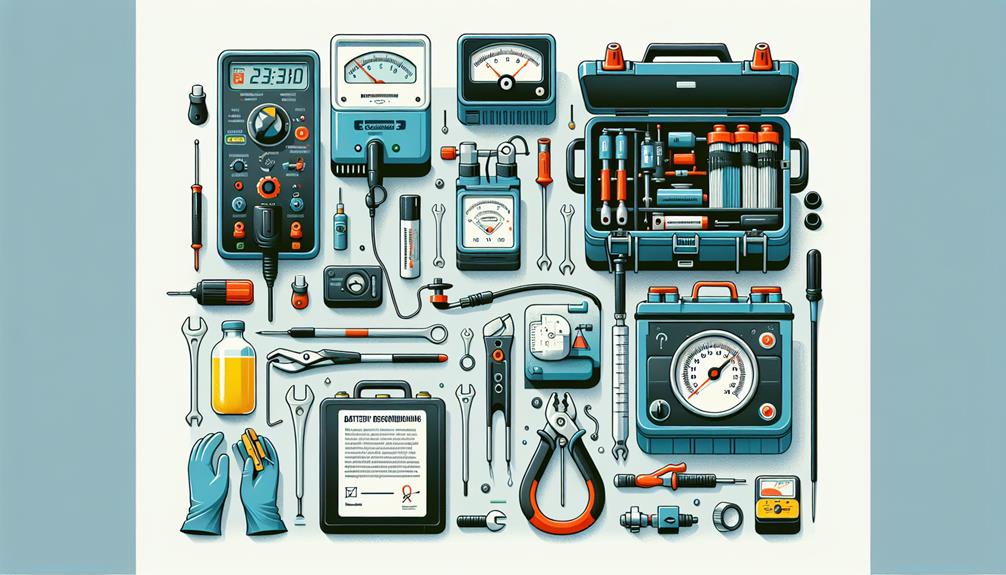What Does Battery Reconditioning Mean
Have you ever had a car battery that lost its charge and thought it was time to get a new one? Well, before you rush to the store, let's talk about battery reconditioning. This process might just save you some money and extend the life of your battery.
What Does Battery Reconditioning Mean
But what exactly does battery reconditioning mean? How does it work? And what are the benefits? In this discussion, we will explore the answers to these questions and provide some tips for successful battery reconditioning.
What Does Battery Reconditioning Mean
So, hang tight, because you're about to uncover a fascinating world of battery rejuvenation that might just change the way you think about those seemingly lifeless power sources.
What Does Battery Reconditioning Mean
Key Takeaways
What Does Battery Reconditioning Mean
- Battery reconditioning is the process of restoring a battery to its optimal functioning state, reversing degradation and extending its lifespan.
- It can be done by individuals at home with the right knowledge and equipment, dispelling the misconception that it can only be done by professionals.
- The process involves steps like cleaning battery terminals, testing the battery's voltage, and using a battery reconditioning charger to remove sulfation buildup.
- Battery reconditioning offers cost savings, environmental benefits by reducing waste, extends battery lifespan, and provides self-sufficiency in power needs.
The Definition of Battery Reconditioning
What Does Battery Reconditioning Mean
Battery reconditioning refers to the process of restoring a battery to its optimal functioning state by reversing the effects of degradation and extending its overall lifespan. This technical procedure is designed to revive batteries that have experienced reduced performance due to factors such as sulfation, which occurs when lead-acid batteries accumulate sulfate crystals on their plates. By using specialized techniques and equipment, battery reconditioning can effectively dissolve these crystals and restore the battery's capacity to hold and deliver electrical energy.
What Does Battery Reconditioning Mean
One of the advantages of battery reconditioning is its ability to save you money. Instead of replacing a battery that's showing signs of deterioration, reconditioning allows you to restore it to its original capabilities, eliminating the need for purchasing a new one. Additionally, battery reconditioning reduces waste and contributes to a more sustainable environment by extending the lifespan of batteries and preventing them from ending up in landfills.
What Does Battery Reconditioning Mean
However, there are common misconceptions about battery reconditioning that need to be addressed. Some people believe that reconditioning can only be done by professionals or that it's a complicated and time-consuming process. In reality, with the right knowledge and equipment, battery reconditioning can be done by individuals at home. It's an accessible and cost-effective solution for improving the performance and lifespan of batteries.
The Process of Battery Reconditioning

To initiate the process of battery reconditioning, you'll need to gather the necessary equipment and follow a series of precise steps to restore the battery to its optimal functioning state. Here is a list of steps in the battery reconditioning process:
- Step 1: Safety Precautions: Before you begin, ensure you're wearing appropriate protective gear such as gloves and safety glasses. Safety should always be a priority.
- Step 2: Cleaning: Thoroughly clean the battery terminals using a mixture of baking soda and water. This will remove any corrosion or dirt that may be affecting the battery's performance.
- Step 3: Testing: Use a multimeter to measure the voltage of the battery. This will help you determine if the battery is capable of being reconditioned or if it needs to be replaced.
- Step 4: Reconditioning: If the battery can be reconditioned, you'll need to connect it to a battery reconditioning charger. This charger will use a controlled electrical current to remove sulfation buildup on the battery plates.
- Step 5: Charging: After the reconditioning process is complete, fully charge the battery using a regular battery charger. This will ensure that the battery is ready for use.
Tools and Techniques for Battery Reconditioning

When reconditioning a battery, it's essential to have the right tools and techniques at your disposal. Battery reconditioning requires certain safety precautions to ensure the process is carried out correctly. One of the most common mistakes in battery reconditioning isn't wearing proper protective gear, such as gloves and goggles, which can lead to injury. Another mistake isn't properly disconnecting the battery from the power source before starting the reconditioning process, which can result in electrical shock.
To successfully recondition a battery, you'll need a few tools. A battery tester is crucial for determining the condition of the battery and identifying any issues. A battery charger is used to recharge the battery and restore its capacity. Additionally, you may need a battery desulfator to remove sulfate buildup, which can improve battery performance.
Techniques for battery reconditioning vary depending on the type of battery being reconditioned. For lead-acid batteries, the most common technique involves charging the battery at a low voltage for a specific period of time. This process helps remove sulfation and restore the battery's capacity. For other types of batteries, such as lithium-ion or nickel-cadmium, different techniques may be required.
Benefits of Battery Reconditioning

Reconditioning a battery offers several advantages that can extend its lifespan and save you money in the long run. Here are some of the benefits you can expect:
- Cost savings: By reconditioning your batteries instead of replacing them, you can save a significant amount of money. Battery reconditioning is a cost-effective solution that allows you to get more use out of your batteries before needing to buy new ones.
- Environmental impact: Battery reconditioning is an environmentally friendly practice. By reusing and restoring old batteries, you contribute to the reduction of electronic waste and the conservation of valuable resources. It helps in minimizing the need for battery disposal and decreases the demand for new batteries, which require the extraction of raw materials.
- Extended battery lifespan: Reconditioning a battery can significantly extend its lifespan. By restoring the battery's performance and capacity, you can continue to use it for a longer period before it needs to be replaced. This means fewer batteries ending up in landfills and more efficient use of resources.
- Versatility: Battery reconditioning isn't limited to a specific type of battery. It can be applied to various types, including lead-acid, lithium-ion, nickel-cadmium, and more. This versatility allows you to recondition a wide range of batteries, providing you with more opportunities for cost savings and environmental benefits.
- Self-sufficiency: Learning how to recondition batteries gives you the ability to take charge of your own power needs. Instead of relying solely on purchasing new batteries, you can recondition your existing ones whenever they start to lose their performance. This self-sufficiency not only saves you money but also gives you a sense of empowerment and control over your energy consumption.
Tips for Successful Battery Reconditioning

If you want to maximize the benefits of battery reconditioning and ensure successful restoration of your batteries, it's essential to follow these expert tips.
First and foremost, regular battery maintenance is crucial for extending battery life. This involves keeping your batteries clean and free from corrosion. Make sure to inspect the terminals and clean them with a mixture of baking soda and water if necessary.
Additionally, it's important to store your batteries properly. Keep them in a cool, dry place to prevent excessive heat or moisture, which can degrade the battery's performance.
Another tip is to avoid overcharging or over-discharging your batteries. This can cause irreversible damage and decrease their lifespan. Use a reliable charger that has overcharge protection and avoid draining the battery completely before recharging.
Finally, it's recommended to use your batteries regularly. Inactive batteries tend to lose their charge over time, so it's important to use them at least once every few months to keep them in good condition.
Frequently Asked Questions
How Long Does Battery Reconditioning Typically Take?
Battery reconditioning typically takes several hours, depending on the type and condition of the battery. The process involves several steps, such as cleaning the battery, testing its capacity, and applying a reconditioning technique to restore its performance.
Can Any Type of Battery Be Reconditioned?
You can recondition most rechargeable batteries. By restoring the battery's capacity, you can extend its lifespan and save money. Reconditioning offers benefits like reducing waste and promoting sustainability.
Is Battery Reconditioning Safe for the Environment?
Battery reconditioning process involves restoring the capacity of old batteries. When done properly, it can be safe for the environment. However, it is crucial to follow proper procedures to minimize any potential environmental impact.
Can Battery Reconditioning Extend the Lifespan of a Battery?
Battery reconditioning can indeed extend the lifespan of a battery. By following simple steps and techniques, you can revive old batteries and enjoy the benefits of longer usage.
Is Battery Reconditioning a Cost-Effective Alternative to Buying New Batteries?
Battery reconditioning offers a cost-effective alternative to buying new batteries. By restoring the performance of old batteries, you can save money and reduce waste. Take advantage of this method instead of battery recycling.
Conclusion
In conclusion, battery reconditioning is a process that restores the performance and lifespan of old or weak batteries. By using various tools and techniques, such as desulfation and equalization, the battery's capacity and efficiency can be improved.
This not only saves money by extending the battery's lifespan, but also reduces waste by recycling and reusing batteries. To achieve successful battery reconditioning, it's important to follow proper guidelines and take necessary precautions.

